Husbandry Excrement Resources
Origin
The current practice of livestock wastewater treatment is to separate the waste by solids and liquids, followed by anaerobic or facultative fermentation and aerobic treatment before it's discharged into rivers and irrigation canals. The approach, however, cannot remove nitrogen and phosphorus from the excrement and wastewater. Thus, the rivers are depleted of oxygen and left with a smell. Unfortunately, in order to cut down the cost on wastewater treatment or facility maintenance, some husbandry business owners might choose not to repair malfunctioned facilities or not to use the facilities and bypass the usual outfall to discharge the wastewater into the rivers instead, causing river pollution. Livestock excrement is rich with nitrogen and phosphorus. If it is discharged into rivers instead of being properly utilized, the resources are misplaced.
Given the situation, the MOENV has set the goal to address the river pollution issues, enhance rural air quality as well as implement the policy of circular economy to recycle livestock excrement and make it into nitrogen fertilizer. Instead of treating excrement as waste on which the MOENV used to control and monitor intensively, the MOENV referred to best practices of other countries and started to promote the strategies of "transforming livestock excrement into resources." After the excrement is processed with anaerobic fermentation, the liquor and fiber digestate can be used as nitrogen fertilizers on the farmland. As a result, farmers will be able to cut down the use of chemical fertilizers, while livestock breeders don’t need to bear the electricity expense on aerobic treatment (the third step) and save some on the water pollution control fee. Water bodies will be cleaner because less polluted water is discharged. Methane can be collected and used for electricity generation or other purposes. This will facilitate the promotion of circular economy and bring benefits to every party involved.
Implementation
To promote the policy of "implementing liquor and fiber digestate as fertilizer for farmlands," the MOENV takes the following measures:
1. Regulation adjustment and practical management
To promote using livestock excrement as farmland fertilizers, the MOENV added a new chapter dedicated to “implementing liquor and fiber digestate as fertilizer for farmlands” in the amended "Water Pollution Control Measures and Test Reporting Management Regulations" (hereinafter as the regulations) in November, 2015, so it can serve as the legal basis.
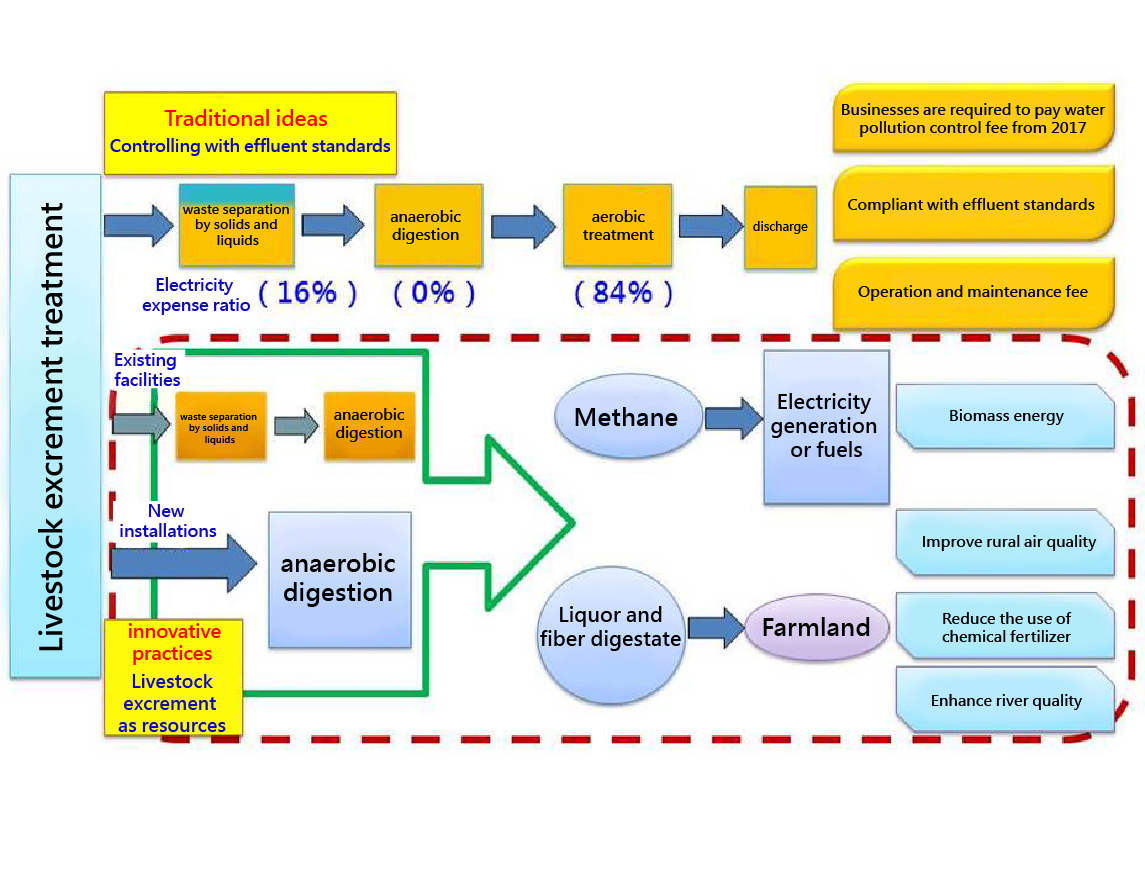 Comparing traditional ideas and innovative practices of livestock excrement treatment
Comparing traditional ideas and innovative practices of livestock excrement treatment
Traditionally, the requirements for animal farming excrements specify control by water discharge criteria. Wastewater shall not be discharged until it is treated with solid-liquid separation, anaerobic fermentation, and aerobic treatment, water discharge criteria are met, and effluent fee and operation and maintenance fee are paid; the innovative way is to convert animal excrements into fertilization purposes. Anaerobic fermentation breaks the excrements down to biogas and liquid and solid digestates, where the former is good for bioenergy for power generation or fuel as well as carbon right offsets; while the latter can be used for farmland fertilization, which reduces the use of chemical fertilizers and, thus, makes the rivers cleaner.
2. Assistance from specialists and segmented services
the MOENV works with local environmental protection authorities by granting financial supports and sending specialists on-site to provide free husbandry consultation services. Services include liquor and fiber digestate quality examination, soil and groundwater component examination, match-making of farmlands to be fertilized, assistance in creating liquor and fiber digestate utilization proposal and applying for approval. the MOENV also introduces the resources from Swine ROC, the Swine Breeders Association with16 branches across the nation offering services to livestock breeders. So local authorities also set up 16 dedicated help desks and consultation hotlines accordingly. With the services offered by the community organizations and full mobilization, the benefits of "implementing liquor and fiber digestate as fertilizer for farmlands" have been publicized extensively. Breeders are also assisted one by one on how to apply for using liquor and fiber digestate as fertilizers.
3. Incremental review and simplified procedures
the MOENV amended the regulations in October 2016 to simplify the inspection items and application procedures. To strongly promote livestock excrement utilization, the regulations were amended on December 27th, 2017, to simplify the application procedures of adding farmlands for fertilizers, exempt permit registration for using fertilizers in farmlands, and simplify content required to report recycling. At the same time, the following standards are set to indicate the required percentage of transforming livestock wastewater (through using liquor and fiber digestate as farmland fertilizers, re-using livestock excrement based on Regulations on Agricultural Waste Reuse, irrigating vegetables if the liquid meets effluent standards) into resources. For newly installed facilities, the percentage of wastewater utilization shall account for more than 10% of the total. For existing facility that raises more than 2,000 pigs or 500 cattle, the target is 5% within 5 years and 10% within 10 years; while those that raise 20 to 2,000 pigs or 40 to 500 cattle should reach 5% within 8 years and 10% within 12 years. The regulations were once again amended on March 8th, 2019 to extend the definition of fertilized farmland, and impose tiered management on excrement recycling based on the fertilization amount and type.
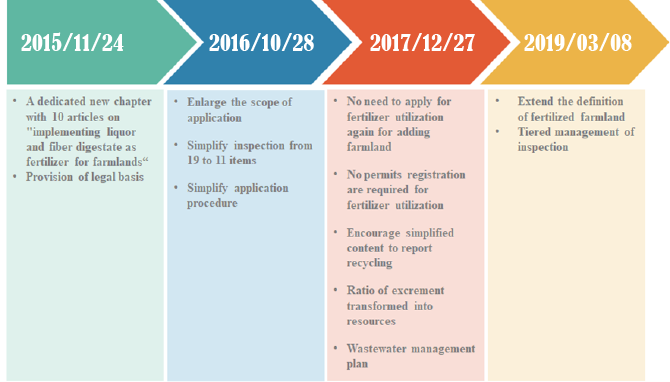 Process of amending "Water Pollution Control Measures and Test Reporting Management Regulations
Process of amending "Water Pollution Control Measures and Test Reporting Management Regulations
EPA studied international experiences and promotions and the development of domestic animal farming industry and consulted R. O. C. Swine and Dairy Farmer Association R. O. C. Taiwan before negotiating with Council of Agriculture, Executive Yuan. On Nov 24 2015, the “Water Pollution Control Measures and Test Reporting Management Regulations” were promulgated which contain a dedicated chapter of “Plan for Implementing Liquor and Fiber Digestate as Fertilizer for Farmlands” for the promotion of management. Also, on Oct 28 2016, the “Water Pollution Control Measures and Test Reporting Management Regulations” were amended to specify those whom the “Plan for Implementing Liquor and Fiber Digestate as Fertilizer for Farmlands” are applicable to, simplify test items and improve management flexibility for wider participation. Again, part of the “Water Pollution Control Measures and Test Reporting Management Regulations” were amended on Dec 27 2017 to specify the percentage and deadline for animal farmers to take resource processing measures, as an effort to move toward the management of excrements for farm fertilizers; on Mar 8 2019, part of the “Water Pollution Control Measures and Test Reporting Management Regulations” were amended to simplify the liquid and solid digestates application procedure and subsequent monitoring frequency for pig farmers who own 200 animals or fewer. The amendment also includes a tiered management system for the conversion of animal excrements to usable resource, as an effort to promote the circular economy measures for animal farming.
4. Regulatory enforcement and inspection
Some livestock breeders were reluctant to improve their practices or comply with policies, so there were still illegal wastewater discharge incidents. After review, the MOENV decided that since it has already provided so many assistances and services to livestock breeders, it also needed more law enforcement efforts. In 2017 and 2018, the MOENV initiated an auditing and inspection project for husbandry industry, starting with the 9 rivers most polluted by animal farming pollution, including Old Zhuoshui River, New Huwei River, Beigang River, Jishui River, Sandie River, Erren River, Yanshui River, Agongdian River, and Donggang River. From 2016 to December 2018, the MOENV conducted 9,473 inspections in the businesses around the catchment areas of heavily polluted rivers (key monitoring stations) and imposed 1,244 penalties on the businesses. The project is scheduled to continue in 2019.
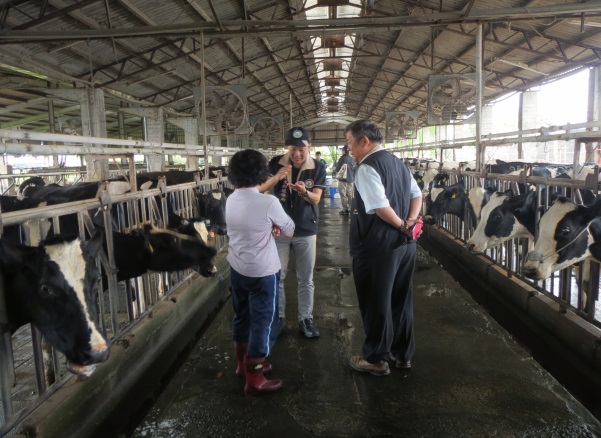 the MOENV sends inspectors to an animal farm in Pingtung County
the MOENV sends inspectors to an animal farm in Pingtung County
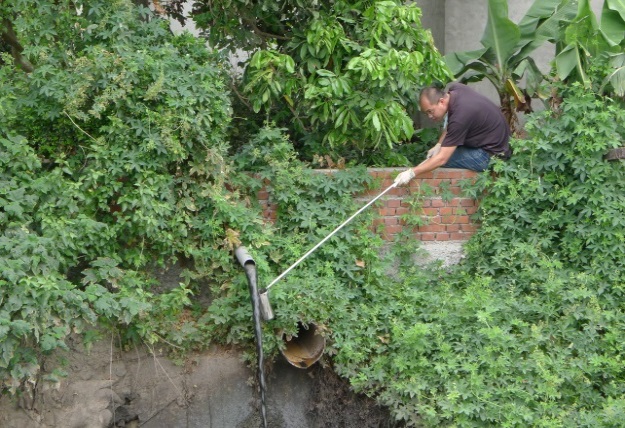 the MOENV sends inspectors to an animal farm in Yunlin County.
the MOENV sends inspectors to an animal farm in Yunlin County.
5. Horizontal collaboration and top-down promotion
To push forward the "plan for implementing liquor and fiber digestate as fertilizer for farmlands," the MOENV subsidizes local governments in helping livestock breeders submit applications of treating liquor and fiber digestate for recycled use, and coordinates agricultural administrative authorities to review fertilizer utilization plans submitted by animal husbandry businesses, so the crops on the fertilized farmland can be irrigated with required fertilizers and quality of farmland environment is protected.
6. Matching agriculture with husbandry and expanding fertilization
- Livestock breeders responded that it was not easy for them to find available farmland for fertilization, so the MOENV organized match-making events focusing on farmers’ organizations, or asked regional farmers' association to add the topic of “implementing liquor and fiber digestate as fertilizer for farmlands” in their promotional courses. 5 match-making events for agriculture and husbandry businesses on "implementing liquor and fiber digestate as fertilizer for farmlands" were organized in 2017, and 10 sessions on the promotion of agriculture and husbandry matching platform for implementing liquor and fiber digestate as fertilizer for farmlands were organized in 2018. The marketing department of farmers' association and the leaders of production and marketing groups were invited to these events, where the MOENV provided the crop and animal farmers with key information for fertilization management, so they felt more confident in using resources transformed from livestock excrement. Another 10 sessions have been scheduled to take place in 2019.
- With information communication technology, an online match-making platform was built for crop and livestock farmers to register the amout of liquor and fiber digestate they can produce and land they have for fertilization. Based on this information, local governments can assist them to contact each other and find partners (http://epafarm.dsmynas.net/farm/index.php?limitstart=0).
- the MOENV also coordinated with Taiwan Sugar Corporation (TSC) and asked it to provide farmlands to be fertilized for free or for rent. For instance, TSC offered Maguang Farm and released 7 hectares of farmland for Yunlin county government to implement the fertilization project in 2018.
- To understand the feasibility of replacing compound fertilizer with livestock excrement and liquor and fiber digestate, the MOENV conducted field experiments to analyze the components required for crops and plants in order to support and promote the policy scientifically. Manuals on fertilization were prepared based on the results of field experiments.
7. Communication events and promotional campaign
(1)the MOENV organized national demo events for promotion, including co-hosting 2 events with Yunlin and Pingtung county governments in 2016 and another 2 large promotional events in 2018. One of them is the milestone ceremony on October 30th to celebrate Yunlin county's successful promotion with over 100 farms using fertilizers transformed from recycled livestock excrement. The other is livestock excrement truck delivery ceremony in Kaohsiung on November 9th. Both events were covered in a dozen articles on media, demonstrating very effective promotion results.
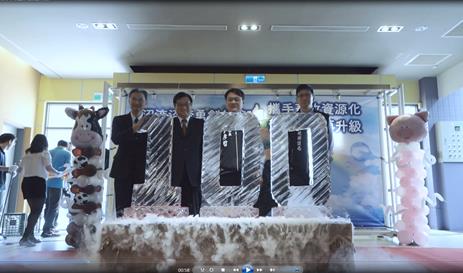 Milestone ceremony to celebrate Yunlin county's successful promotion with over 100 farms fertilizers transformed from recycled livestock excrement on October 30th, 2018.
Milestone ceremony to celebrate Yunlin county's successful promotion with over 100 farms fertilizers transformed from recycled livestock excrement on October 30th, 2018.
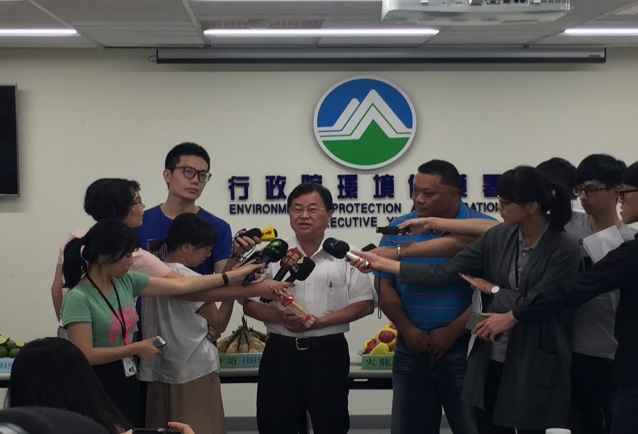 the MOENV's press conference on “transforming livestock excrement into resources and enhancing river water quality” on July 16th, 2019
the MOENV's press conference on “transforming livestock excrement into resources and enhancing river water quality” on July 16th, 2019
(2)Promotional videos and audiotape were made to facilitate the implementation. In 2017, the video was on cable TV and broadcast television 900 times, while the audio was on regional radio station 3,042 times. the MOENV also worked with "TV Shopping with MeiFeng" and other micro series to incorporate the promotional materials. In 2018, the videos were advertised 288 times on the homepage and free sections of digital channel MOD.
(3)20,000 promotional pamphlets were printed for advocacy.
8. To accelerate centralized treatment and reuse of the animal excrement, the MOENV has offered 2 subsidies.
(1)On February 23rd, 2018, the MOENV passed down the instruction to subsidize a project to support local governments setting up treatment facilities to manage the excrement of other livestock farms. Thus livestock excrement treatment can be centralized, and small farms can commission bigger farms for the recycling work. Subsidies for centralized treatment have been approved for 1 center in Hualien County. Subsidies for small farms commissioning bigger farms have been approved for 1 case in Taoyuan City, 2 cases in Pingtung County and 5 cases in Yunlin County. As a whole, 30 farms are supported to process the excrement of 79,117 pigs and 697 cattle. The total amount of subsidy is NTD 133.65 million dollars.
(2)On May 10th, 2018, the MOENV subsidized local governments for procurement plans of excrement collection trucks, fertilizing vehicles or equipment, and storage tanks, so that the local governments will be able to establish a fertilizing system with more flexibility. The funding has been approved for Kaohsiung City, Taichung City, Yunlin County, Pingtung County, Hualien County and Chiayi County. 25 collection/fertilizer trucks and 75 storage tanks can be purchased with the total subsidy amount of NTD 46.41 million dollars.
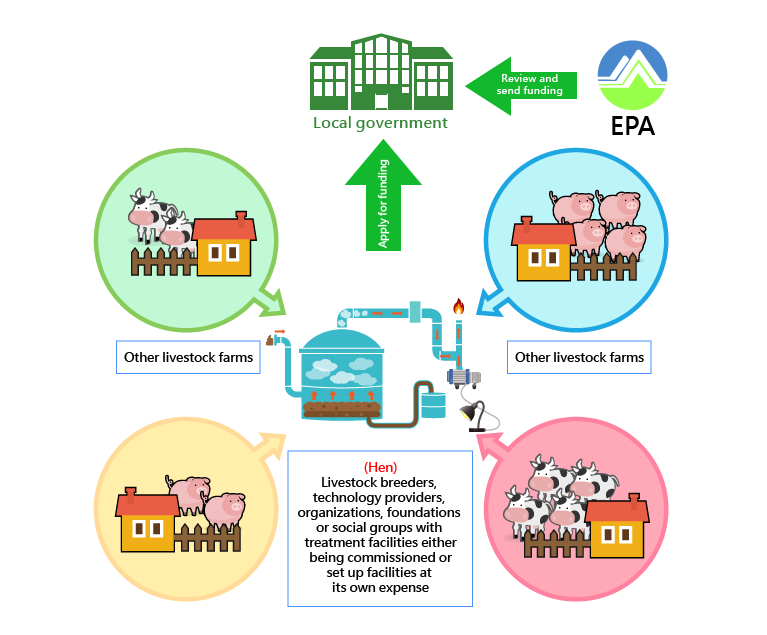 Husbandry Excrement Resources
Husbandry Excrement Resources
Animal farmers and technical suppliers, agencies, nonprofit corporations or social groups that are interested in establishing animal excrement resource conversion equipment may apply to local government for subsidies, which are provided to local governments with the approval of EPA.
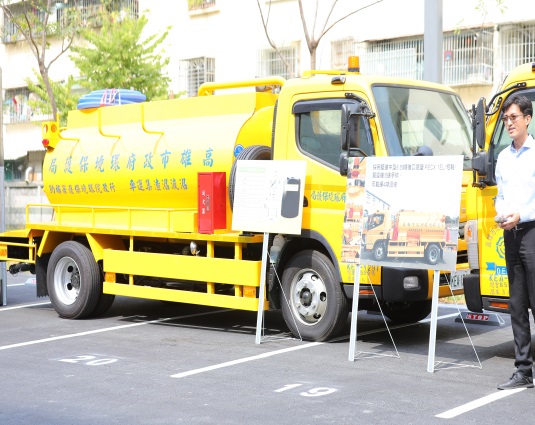 liquor and fiber digestate collection trucks
liquor and fiber digestate collection trucks
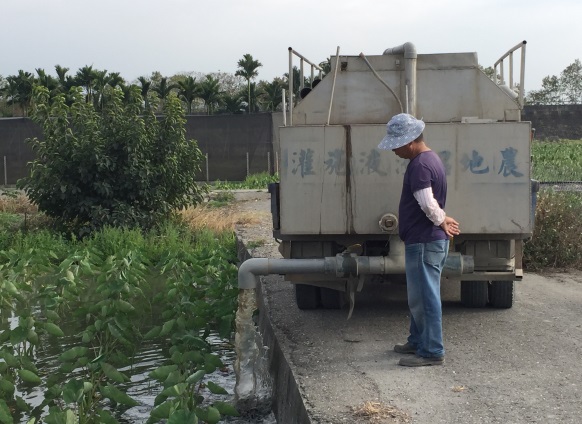 Collection/Fertilizer trucks
Collection/Fertilizer trucks
 Fertilizing equipment
Fertilizing equipment
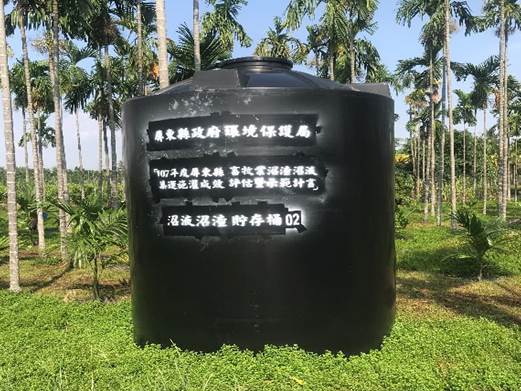 Storage tanks
Storage tanks
9. Demo township of transforming livestock excrement into resources
For the pilot run of the project, the MOENV chose 2 townships with relatively more livestock businesses as demo townships to promote "transforming livestock excrement into resources." The expectation was to increase and accelerate the popularity of recycling excrement resources by showing its effects directly to livestock businesses, production and marketing co-ops, or related authorities and organizations; discussing with opinion leaders and providing technical training. After a year of efforts, in addition to the 9 farms which have already agreed to use excrement fertilizers and final effluent for plant irrigation, Wanluan Township in Pingtung County successfully received 11 more applications. Meanwhile, Mailiao Township in Yunlin County saw 10 more approved excrement treatment farms. In 2019, the MOENV planned to implement the project in 8 more demo townships.
Results
As of June 30th, 2019, the number of livestock farms transforming excrement into resources across Taiwan has reached 725, with 4.05 million tons of fertilizers used per year, 13.99% of reuse rate, and 2,120 hectares of fertilized farmland. The method also managed to reduce 25,032 tons of organic pollutants per year, equivalent to the results of 456 gravel aeration plants with 10,000 tons of daily capacity (saving 45.6 billion dollars of budgets). The volume of nitrogen used for fertilization was 850 tons/ year, equivalent to 132,856 packs of Taiwan Fertilizer's #5 Compound Fertilizer, saving 45.17 million dollars of fertilizer expenses per year.
Statistics of transforming livestock excrement into resources in Taiwan
| Item |
Number of livestock farms |
Area(hectare) |
Reported excrement (per 10,000 ton/year) |
Reduced BOD (ton/year) |
Nitrogen content (ton/year) |
| Nationwide(Reported water pollution control fee) |
5,750 |
|
2,898 |
|
|
| Transforming method |
Number of farms |
Area(hectare) |
Fertilization (ton/year) |
Reduced BOD (ton/year) |
Nitrogen content (ton/year) |
| 1. Liquor and fiber digestate used as fertilizer |
560 |
1,582 |
188 |
11,227 |
631 |
| 2.Individual cases of excrement reuse |
91 |
53 8 8 |
5 5 5 |
2,98 8 8 |
219 |
| 3. Water resource reuse |
74 |
- |
162 |
10,817 |
- |
| Total |
725 |
2,120 |
405 |
25,032 |
850 |
| Percentage |
12.61% |
|
13.99% |
|
|
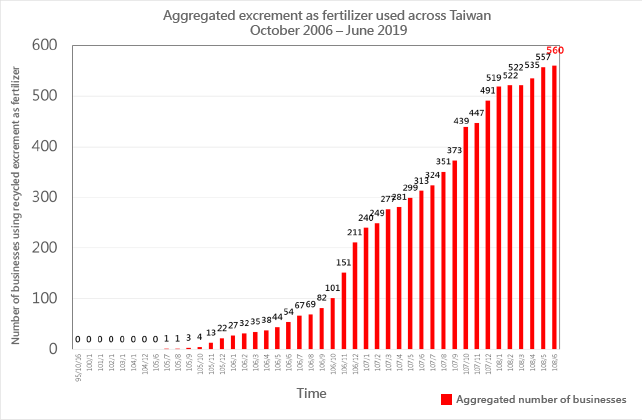 Aggregated excrement as fertilizer used across Taiwan
Aggregated excrement as fertilizer used across Taiwan
The number of animal farms that convert animal excrements to fertilizers has shown signs of increase since 2006, and up to 560 farms practiced such conversion as of 2019.